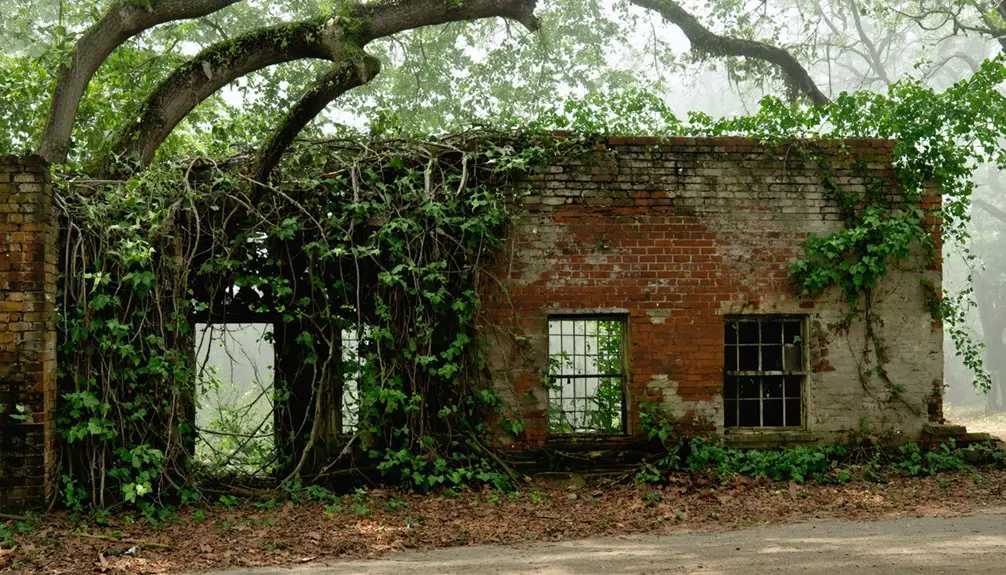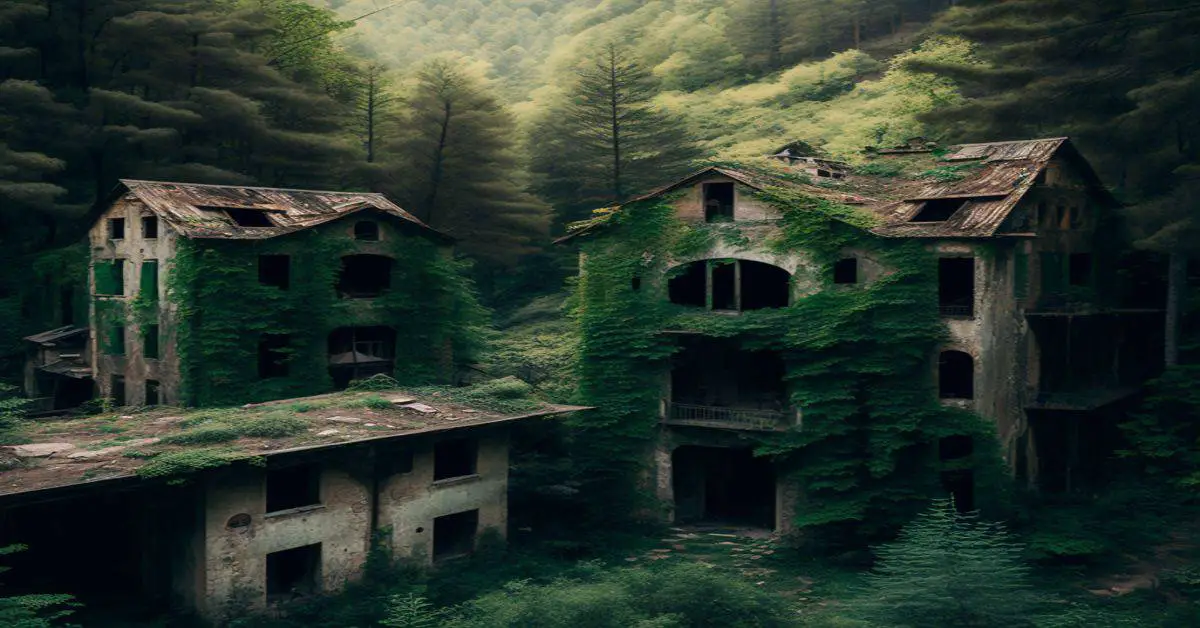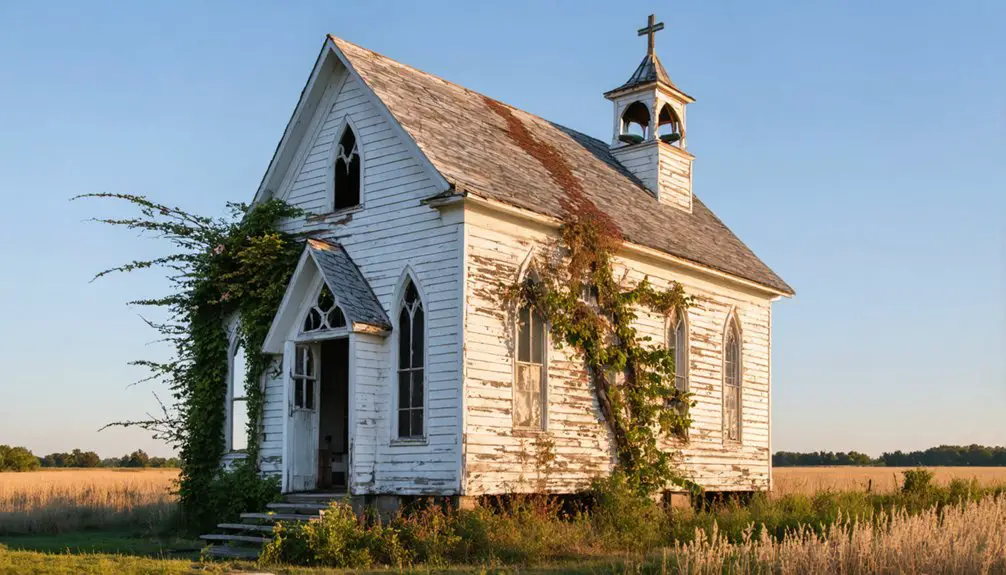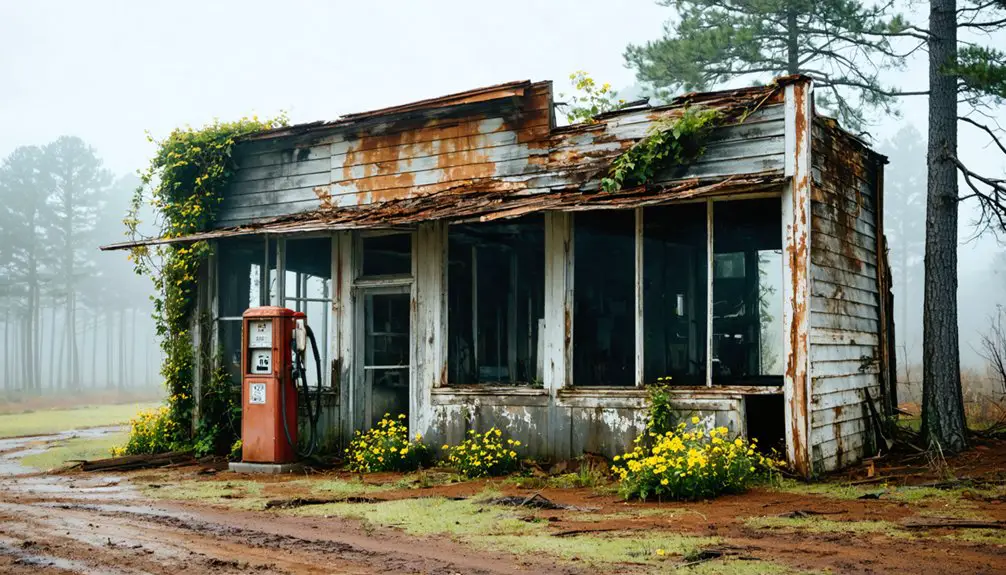You’ll find Rocky Springs along Mississippi’s historic Natchez Trace, where a natural spring attracted Native Americans, Spanish explorers, and American settlers in the late 1700s. The town flourished into a bustling cotton-farming community of 2,616 residents by 1860, but yellow fever epidemics, boll weevils, and soil erosion led to its abandonment by 1940. Today, only the 1837 Methodist Church stands intact among moss-covered ruins and weathered tombstones, offering glimpses into this once-prosperous Southern town’s fascinating past.
Key Takeaways
- Rocky Springs was a thriving Mississippi town established in the late 1700s along the Natchez Trace, reaching 2,616 residents by 1860.
- Yellow fever epidemics in 1878 and 1888, combined with boll weevil infestations and soil erosion, led to the town’s eventual abandonment.
- The 1837 Methodist Church remains the only intact building from the original settlement, now used only for special gatherings.
- Two post office safes, a covered cistern, and an old cemetery with weathered tombstones are among the visible remnants.
- Nature has reclaimed most of the ghost town, with dense vegetation and moss-draped trees now covering the once-bustling streets.
A Town Born From Natural Springs
While many frontier towns emerged around rivers or railroads, Rocky Springs grew from a natural watering spot that proved crucial to travelers along the Natchez Trace in the late 1700s.
You’ll find the town’s origins traced to a Spanish lieutenant who named it “La Fuente del Pedregal” – meaning Rocky Springs.
Early settlers recognized the spring’s value as a significant natural resource, with Mayburn Cooper claiming land there by 1796.
The site’s reliable water source attracted more pioneers, transforming it from a simple rest stop into a thriving community. Isaac Powers’ tavern became a vital meeting point for mail carriers traveling north and south.
As travelers and traders gathered around this life-giving spring, a proper town took shape. By 1860, the prosperous settlement reached a population of 2,616 residents.
Life Along the Historic Natchez Trace
The life-sustaining springs that birthed Rocky Springs were part of a much older and grander network – the Natchez Trace. For over 10,000 years, this historic corridor served as a essential lifeline connecting diverse cultures and communities across the region. The 444-mile route remains a testament to the ancient pathways that shaped American history.
The cultural significance of the Trace runs deep, from its origins as Native American trading paths to its evolution as a critical commercial route for early American settlers. The route became known as The Devil’s Backbone due to its remote and dangerous conditions.
The Natchez Trace weaves through time, linking ancient Native American footpaths to the vital trading routes of America’s frontier days.
- Natchez, Chickasaw, and Choctaw nations used the trail for trade and cultural exchange, leaving behind ceremonial mounds and archaeological treasures.
- Traders returning from Mississippi River flatboat journeys relied on the Trace as their path home.
- Natural springs and rest stops dotted the route, offering refuge to weary travelers.
- The U.S. government officially established it as a post road in 1800, improving the route with bridges and maintenance.
The Rise and Flourishing Years
Settlers first discovered Rocky Springs in 1790 as a natural watering place along the Natchez Trace, marking the beginning of what would become a thriving antebellum community.
You’d have witnessed remarkable community development as the town grew from Mayburn Cooper’s early settlement to a bustling population of over 2,600 by 1860. The era of economic prosperity brought diverse professionals to town, including merchants, physicians, teachers, and clergy.
Cotton farming drove the economy, with 54 planters and 28 overseers managing vast agricultural operations. The community included over 2,000 slaves who worked the cotton fields. You’d have found the Rocky Springs Academy, established in 1838, educating planters’ sons, while the Methodist church served as the town’s spiritual center. The town was named after a spring called La Fuente del Pedregal by Spanish explorers.
A network of stores, taverns, and postal services supported both residents and travelers along the Natchez Trace.
Forces Behind the Town’s Decline
You’ll find that Rocky Springs’ downward spiral began with devastating yellow fever epidemics in 1878 and 1888, which decimated the population and severely disrupted the town’s economic stability.
The agricultural crisis deepened in the early 1900s when the boll weevil infestation destroyed the cotton crops that formed the backbone of the local economy.
Poor soil management and severe erosion then delivered the final blow, rendering the once-fertile farmland increasingly unsuitable for cultivation and accelerating the town’s decline.
Diseases and Economic Hardship
During the late 1800s, Rocky Springs faced a devastating one-two punch of yellow fever epidemics that ravaged its population and destabilized the community. The disease impact was catastrophic, with outbreaks in 1878 and 1888 causing widespread death and triggering an exodus of survivors. At its peak, the town supported a vibrant economy with over fifty planters working the surrounding farmland.
This health crisis coincided with mounting economic struggles that would ultimately seal the town’s fate.
- The boll weevil invasion decimated cotton crops, destroying the town’s primary source of income.
- Poor farming practices and soil erosion steadily reduced agricultural productivity.
- Burdensome taxes strained already struggling farmers and businesses.
- Essential services, including the post office and final store, shuttered by 1930.
You’ll find these combined pressures transformed a once-thriving community into a ghost town, with complete abandonment by 1940.
Environmental Devastation Strikes
While disease and economic hardship dealt heavy blows to Rocky Springs, environmental devastation proved equally destructive to the town’s survival.
You’d have witnessed the town’s agricultural decline through severe soil erosion that developed over years of poor farming practices, destroying once-fertile land.
The environmental impact grew worse when the spring that gave the town its name stopped flowing, and the boll weevil invasion of 1905 devastated the cotton crops that farmers depended on.
These natural assaults stripped away Rocky Springs’ ability to sustain itself. Without productive soil or reliable water sources, farmers couldn’t maintain their livelihoods. Like the First Baptist Church in Rodney, Rocky Springs’ deteriorating structures serve as silent witnesses to nature’s reclaiming force.
Originally a bustling community with a population of 2,600 by 1860, the landscape you’ll find today – ruins hidden among trees and overgrowth – stands as proof to how environmental challenges sealed the town’s fate.
What Remains: Landmarks and Ruins Today
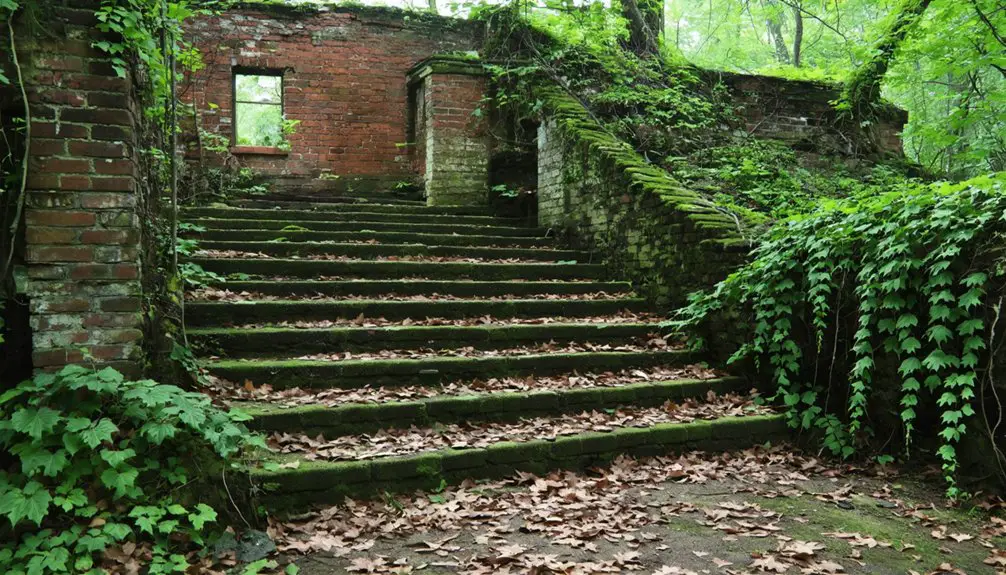
As you walk through Rocky Springs today, you’ll find the 1837 Methodist Church standing as the sole intact building from the original settlement, surrounded by a weathered cemetery filled with centuries-old tombstones.
Nature has reclaimed much of the town’s footprint, with moss-draped trees growing among the ruins of the Red Tavern and scattered remnants of agricultural structures. The town’s decline began when yellow fever devastated the population.
Two post office safes, a covered cistern, and deep erosion gullies serve as stark reminders of both the town’s once-thriving infrastructure and the environmental mismanagement that contributed to its downfall.
Standing Historical Structures
Remnants of Rocky Springs’ once-vibrant community stand as silent witnesses to its past glory.
You’ll find the 1837 Methodist Church, the town’s sole surviving historic structure, commanding attention with its architectural features and historical significance. While regular services ended in 2010, this preserved building continues to host special community gatherings under National Park Service protection.
- The church structure represents the last active link to the town’s thriving past
- A crumbling cemetery adjacent to the church holds weathered headstones of original settlers
- Foundation ruins and a cistern peek through dense vegetation across the site
- You can safely explore the church grounds during daylight hours
Take care when traversing the area, as soil erosion has created hidden ground holes among the scattered remnants of this once-prosperous town.
Hidden Remnants Among Nature
Today, nature steadily reclaims the once-bustling streets of Rocky Springs, where dense vegetation and moss-draped trees obscure the scattered remnants of this abandoned town.
As you explore the site, you’ll find hidden treasures beneath the natural reclamation: old furniture fragments, two preserved safes, and personal belongings half-buried in the shifting soil.
The terrain itself tells a story of abandonment, with severe erosion creating hazardous gullies and unstable ground.
Near the Methodist Church, weathered headstones in the partially sunken graveyard stand as silent witnesses to the town’s former inhabitants.
While most structures have crumbled into mere foundations, you can still spot hints of the past through scattered ruins, including a covered cistern and building remnants slowly disappearing beneath the encroaching wilderness.
Exploring a Piece of Southern History
When you explore Rocky Springs today, you’ll discover a fascinating window into antebellum Southern life through the remains of this once-thriving Mississippi town. The site’s cultural heritage spans from its humble beginnings as a Spanish-noted spring to its peak as a bustling community of 4,600 residents.
Its historical significance is preserved through carefully maintained landmarks that tell the story of prosperity, conflict, and eventual decline.
- The 1837 Methodist Church stands as a monument to the town’s religious foundations, established by pioneer preacher Tobias Gibson.
- Former cotton fields and eroded gullies reveal the agricultural boom that both built and ultimately contributed to the town’s downfall.
- The old cemetery contains weathered gravestones that chronicle generations of settlers and their stories.
- Remnants like historic safes and the dried spring reflect the evolution from essential trade stop to ghost town.
Frequently Asked Questions
Are There Any Reported Ghost Sightings or Paranormal Activities in Rocky Springs?
Over 100 ghost stories have emerged since 1826, and you’ll encounter Lt. David Weeks Magill’s spirit at McNutt House, where paranormal investigations reveal door-slamming activity and a child ghost named Maggie.
What Happened to the Families Who Left Rocky Springs?
You’ll find the family legacies scattered across Mississippi and beyond, as folks left their abandoned homes seeking better opportunities in nearby towns, urban centers, and northern regions during the late 1800s.
Can Visitors Enter the Methodist Church During Non-Service Hours?
Open doors welcome weary souls. You can enter the Methodist church during non-service hours for quiet reflection, as it’s accessible year-round. Just remember proper visitor etiquette and respect the sacred space.
Is Camping Allowed at the Rocky Springs Historic Site?
You can camp at the historic site’s designated campground at milepost 54.8, following basic camping regulations like maximum stays of 14 consecutive days and site limits of 6 people per spot.
How Safe Is the Drinking Water From Remaining Wells or Springs?
Potentially perilous conditions make drinking from these wells dangerous. You shouldn’t consume untreated well water due to historical contamination risks, leaking infrastructure, and lack of current safety testing or monitoring.
References
- https://www.youtube.com/watch?v=tAAp1JB7kd8
- https://www.legendsofamerica.com/ms-rockysprings/
- https://en.wikipedia.org/wiki/Rocky_Springs
- https://roamlab.com/rocky-springs-ghost-town/
- https://civilwartalk.com/threads/rocky-springs-ms-ghost-town.209562/
- http://sites.rootsweb.com/~msclaib3/rocky-springs.htm
- https://www.hmdb.org/m.asp?m=80147
- https://npshistory.com/publications/natr/brochures/chronology.pdf
- https://en.wikipedia.org/wiki/Natchez_Trace
- https://www.worldhistory.org/timeline/Natchez_Trace/
